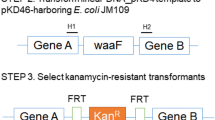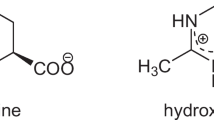Abstract
Colanic acid (CA) is a major exopolysaccharide synthesized by Escherichia coli that serves as a constituent of biofilm matrices. CA demonstrates potential applications in the food, cosmetics, and pharmaceutical industry. Moreover, l-fucose, a monomeric constituent of CA, exhibits various physiological activities, such as antitumor, anti-inflammatory, and skin-whitening. Here, the effects of genetic and environmental perturbations were investigated for improving CA production by E. coli. When rcsF, a positive regulator gene of CA synthesis, was expressed in E. coli ΔwaaF, a CA-producing strain constructed previously, the CA titer increased to 3051.2 mg/L as compared to 2052.8 mg/L observed with E. coli ΔwaaF. Among the environmental factors tested, namely, osmotic and oxidative stresses and pH, pH was a primary factor that significantly improved CA production. When the pH of the culture medium of E. coli ΔwaaF + rcsF was maintained at 7, the CA titer significantly increased to 4351.6 mg/L. The CA yield obtained with E. coli ΔwaaF + rcsF grown at pH 7 was 5180.4 mg CA/g dry cell weight, which is the highest yield of CA reported so far. This engineered E. coli system with optimization of environmental conditions can be employed for fast and economically-feasible production of CA.







Similar content being viewed by others
Data Availability
All data generated or analyzed during this study are included in this manucript.
Code Availability
Not applicable.
References
Danese, P. N., Pratt, L. A., & Kolter, R. (2000). Exopolysaccharide production is required for development of Escherichia coli K-12 biofilm architecture. Journal of Bacteriology, 182(12), 3593–3596.
Costerton, J. W., Lewandowski, Z., Caldwell, D. E., Korber, D. R., & Lappin-Scott, H. M. (1995). Microbial biofilms. Annual Review of Microbiology, 49(1), 711–745.
Chen, J., Lee, S. M., & Mao, Y. (2004). Protective effect of exopolysaccharide colanic acid of Escherichia coli O157:H7 to osmotic and oxidative stress. International Journal of Food Microbiology, 93(3), 281–286.
Ophir, T., & Gutnick, D. L. (1994). A role for exopolysaccharides in the protection of microorganisms from desiccation. Applied and Environmental Microbiology, 60(2), 740–745.
Brown, M., & Gilbert, P. (1993). Sensitivity of biofilms to antimicrobial agents. Journal of Applied Microbiology, 74, 87S-97S.
Kim, M. S., Kim, Y. D., Hong, S. S., Park, K., Ko, K. S., & Myung, H. (2015). Phage-encoded colanic acid-degrading enzyme permits lytic phage infection of a capsule-forming resistant mutant Escherichia coli strain. Applied and Environmental Microbiology, 81(3), 900–909.
Rskov, I., Rsikov, F., Jann, B., & Jann, K. (1977). Serology, chemistry, and genetic of O and K antigens of E. coli. Bacteriological Reviews, 41, 667–710.
Mao, Y., Doyle, M. P., & Chen, J. (2001). Insertion mutagenesis of wca reduces acid and heat tolerance of enterohemorrhagic Escherichia coli O157:H7. Journal of Bacteriology, 183(12), 3811–3815.
Grant, W. D., Sutherland, I. W., & Wilkinson, J. F. (1969). Exopolysaccharide colanic acid and its occurrence in the Enterobacteriaceae. Journal of Bacteriology, 100(3), 1187–1193.
Markovitz, A. (1977). Genetics and regulation of bacterial capsular polysaccharide biosynthesis and radiation sensitivity (pp. 415–462). Academic Press, London.
Stevenson, G., Andrianopoulos, K., Hobbs, M., & Reeves, P. R. (1996). Organization of the Escherichia coli K-12 gene cluster responsible for production of the extracellular polysaccharide colanic acid. Journal of Bacteriology, 178(16), 4885–4893.
Rättö, M., Verhoef, R., Suihko, M.-L., Blanco, A., Schols, H. A., Voragen, A. G. J., Wilting, R., Siika-aho, M., & Buchert, J. (2006). Colanic acid is an exopolysaccharide common to many enterobacteria isolated from paper-machine slimes. Journal of Industrial Microbiology and Biotechnology, 33(5), 359–367.
Sutherland, I. W. (1969). Structural studies on colanic acid, the common exopolysaccharide found in the enterobacteriaceae, by partial acid hydrolysis. Oligosaccharides from colanic acid. Biochemical Journal, 115(5), 935–945.
Han, B., Sivaramakrishnan, P., Lin, C.-C. J., Neve, I. A. A., He, J., Tay, L. W. R., Sowa, J. N., Sizovs, A., Du, G., Wang, J., Herman, C., & Wang W. C. (2017). Microbial genetic composition tunes host longevity. Cell, 169(7), 1249–1262.
Liu, D., Cao, Y., Qu, R., Gao, G., Chen, S., Zhang, Y., Wu, M., Ma, T., & Li, G. (2019). Production of bacterial cellulose hydrogels with tailored crystallinity from Enterobacter sp. FY-07 by the controlled expression of colanic acid synthetic genes. Carbohydrate Polymers, 207, 563–570.
Becker, D. J., & Lowe, J. B. (2003). Fucose: biosynthesis and biological function in mammals. Glycobiology, 13(7), 41R-53R.
Lee, S.-H., Ko, C.-I., Jee, Y., Jeong, Y., Kim, M., Kim, J.-S., & Jeon, Y.-J. (2013). Anti-inflammatory effect of fucoidan extracted from Ecklonia cava in zebrafish model. Carbohydrate Polymers, 92(1), 84–89.
Fernando, I. P. S., Sanjeewa, K. K. A., Samarakoon, K. W., Kim, H.-S., Gunasekara, U. K. D. D. S., Park, Y.-J., Abeytunga, D. T. U., Lee, W. W., & Jeon, Y.-J. (2018). The potential of fucoidans from Chnoospora minima and Sargassum polycystum in cosmetics: antioxidant, anti-inflammatory, skin-whitening, and antiwrinkle activities. Journal of Applied Phycology, 30(6), 3223–3232.
Robert, C., Robert, A. M., & Robert, L. (2005). Effect of a preparation containing a fucose-rich polysaccharide on periorbital wrinkles of human voluntaries. Skin Research and Technology, 11(1), 47–52.
Robert, L., Labat-Robert, J., & Robert, A.-M. (2009). Physiology of skin aging. Pathologie Biologie, 57(4), 336–341.
Péterszegi, G., Isnard, N., Robert, A. M., & Robert, L. (2003). Studies on skin aging. Preparation and properties of fucose-rich oligo-and polysaccharides. Effect on fibroblast proliferation and survival. Biomedicine & Pharmacotherapy, 57(5–6), 187–194.
Péterszegi, G., Fodil-Bourahla, I., Robert, A. M., & Robert, L. (2003). Pharmacological properties of fucose. Applications in age-related modifications of connective tissues. Biomedicine & Pharmacotherapy, 57(5–6), 240–245.
Yu, S., Liu, J.-J., Yun, E. J., Kwak, S., Kim, K. H., & Jin, Y.-S. (2018). Production of a human milk oligosaccharide 2′-fucosyllactose by metabolically engineered Saccharomyces cerevisiae. Microbial Cell Factories, 17(1), 1–10.
Majdalani, N., Heck, M., Stout, V., & Gottesman, S. (2005). Role of RcsF in signaling to the Rcs phosphorelay pathway in Escherichia coli. Journal of Bacteriology, 187(19), 6770–6778.
Ren, G., Wang, Z., Li, Y., Hu, X., & Wang, X. (2016). Effects of lipopolysaccharide core sugar deficiency on colanic acid biosynthesis in Escherichia coli. Journal of Bacteriology, 198(11), 1576–1584.
Parker, C. T., Kloser, A. W., Schnaitman, C. A., Stein, M. A., Gottesman, S., & Gibson, B. W. (1992). Role of the rfaG and rfaP genes in determining the lipopolysaccharide core structure and cell surface properties of Escherichia coli K-12. Journal of Bacteriology, 174(8), 2525–2538.
Shiba, Y., Miyagawa, H., Nagahama, H., Matsumoto, K., Kondo, D., Matsuoka, S., Matsumoto, K., & Hara, H. (2012). Exploring the relationship between lipoprotein mislocalization and activation of the Rcs signal transduction system in Escherichia coli. Microbiology, 158(5), 1238–1248.
Pontel, L. B., Pezza, A., & Soncini, F. C. (2010). Copper stress targets the Rcs system to induce multiaggregative behavior in a copper-sensitive Salmonella strain. Journal of Bacteriology, 192(23), 6287–6290.
Castelli, M. E., & Véscovi, E. G. (2011). The Rcs signal transduction pathway is triggered by enterobacterial common antigen structure alterations in Serratia marcescens. Journal of Bacteriology, 193(1), 63–74.
Majdalani, N., & Gottesman, S. (2005). The Rcs phosphorelay: A complex signal transduction system. Annual Review of Microbiology, 59, 379–405.
Brill, J. A., Quinlan-Walshe, C., & Gottesman, S. (1988). Fine-structure mapping and identification of two regulators of capsule synthesis in Escherichia coli K-12. Journal of Bacteriology, 170(6), 2599–2611.
Cho, S.-H., Szewczyk, J., Pesavento, C., Zietek, M., Banzhaf, M., Roszczenko, P., Asmar, A., Laloux, G., Hov, A.-K., Leverrier, P., Van der Henst, C., Vertommen, D., Typas, A., & Collet, J.-F. (2014). Detecting envelope stress by monitoring β-barrel assembly. Cell, 159(7), 1652–1664.
Han, H. M., Kim, I. J., Yun, E. J., Lee, J. W., Cho, Y., Jin, Y.-S., & Kim, K. H. (2021). Overproduction of exopolysaccharide colanic acid by Escherichia coli by strain engineering and media optimization. Applied Biochemistry and Biotechnology, 193(1), 111–127.
Blumenkrantz, N., & Asboe-Hansen, G. (1973). New method for quantitative determination of uronic acids. Analytical Biochemistry, 54(2), 484–489.
Navasa, N., Rodríguez-Aparicio, L., Martínez-Blanco, H., Arcos, M., & Ferrero, M. Á. (2009). Temperature has reciprocal effects on colanic acid and polysialic acid biosynthesis in E. coli K92. Applied Microbiology and Biotechnology, 82(4), 721–729.
Li, J., Kisara, K., Danielsson, S., Lindström, M. E., & Gellerstedt, G. (2007). An improved methodology for the quantification of uronic acid units in xylans and other polysaccharide. Carbohydrate Research, 342(11), 1442–1449.
Scott, R. W. (1979). Colorimetric determination of hexuronic acids in plant materials. Analytical Chemistry, 51(7), 936–941.
Villa, F., Remelli, W., Forlani, F., Gambino, M., Landini, P., & Cappitelli, F. (2012). Effects of chronic sub-lethal oxidative stress on biofilm formation by Azotobacter vinelandii. Biofouling, 28(8), 823–833.
Wang, H., Wang, F., Wang, W., Yao, X., Wei, D., Cheng, H., & Deng, Z. (2014). Improving the expression of recombinant proteins in E. coli BL21(DE3) under acetate stress: An alkaline pH shift approach. PLoS One, 9(11)
Acknowledgements
We acknowledge the facility support by the Institute of Biomedical and Food Safety at CJ Food Safety Hall, Korea University.
Funding
This work was supported by the Mid-career Researcher Program through the National Research Foundation of Korea (2020R1A2B5B02002631) and the Korea Institute of Planning and Evaluation for Technology in Food, Agriculture, Forestry, and Fisheries, funded by the Ministry of Agriculture, Food, and Rural Affairs (321036051SB010).
Author information
Authors and Affiliations
Contributions
KHK and YSJ conceived the project. YC and EJY designed the experiments. YC, EJY, NRH, and IJK performed the microbial fermentation and product analysis. YC, EJY, and KHK wrote the manuscript. All authors read and approved the fnal manuscript.
Corresponding authors
Ethics declarations
Ethics Approval
This article does not contain any studies with human participants or animals performed by any of the authors.
Consent to Participate
Not applicable.
Consent for Publication
Not applicable.
Conflict of Interest
K.H.K., E.J.Y., and Y.C. have filed a patent on a part of this work.
Additional information
Publisher's Note
Springer Nature remains neutral with regard to jurisdictional claims in published maps and institutional affiliations.
Eun Ju Yun and Yoonho Cho contributed equally to this work.
Supplementary Information
Below is the link to the electronic supplementary material.
Rights and permissions
About this article
Cite this article
Yun, E.J., Cho, Y., Han, N.R. et al. Increased Production of Colanic Acid by an Engineered Escherichia coli Strain, Mediated by Genetic and Environmental Perturbations. Appl Biochem Biotechnol 193, 4083–4096 (2021). https://doi.org/10.1007/s12010-021-03671-0
Received:
Accepted:
Published:
Issue Date:
DOI: https://doi.org/10.1007/s12010-021-03671-0




